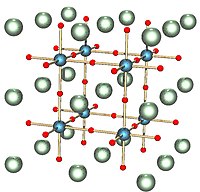
Photo from wikipedia
Abstract A series of bio-silica incorporated barium-ferrite-composites with the composition of (x)Bio-SiO2:(80-x)γ-Fe2O3:(20)BaO, where x = 0, 1, 2, and 3 wt% were prepared using the modified solid-state reaction method. The influence of different… Click to show full abstract
Abstract A series of bio-silica incorporated barium-ferrite-composites with the composition of (x)Bio-SiO2:(80-x)γ-Fe2O3:(20)BaO, where x = 0, 1, 2, and 3 wt% were prepared using the modified solid-state reaction method. The influence of different bio-silica (extricated from sintered rice husk) contents on the surface morphologies, structures, and magnetic characteristics of these composites were assessed. The relative complex permittivity and permeability were resolved using the Nicholson-Ross-Weir strategy in the frequency range of 8–13 GHz. Meanwhile, the reflection loss was estimated through the transmission/reflection line theory to assess the MW absorption properties of the composites. Incorporation of the bio-silica in the barium ferrite composites generated a new hexagonal phase (Ba3Fe32O51) and a tetragonal phase (BaFeSi4O10) which led to a decrease in the saturation magnetization and significant shift in the MW frequency absorption peak positions.
Journal Title: Current Applied Physics
Year Published: 2020
Link to full text (if available)
Share on Social Media: Sign Up to like & get
recommendations!